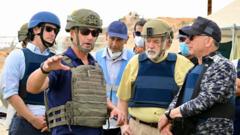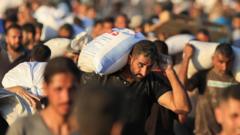The visit highlights the complexities of the Israeli-Palestinian conflict as details surrounding aid distribution and civilian safety emerge.
**Trump Envoy's Visit to Gaza Aid Site Sparks Controversy and Criticism**

**Trump Envoy's Visit to Gaza Aid Site Sparks Controversy and Criticism**
U.S. envoy Steve Witkoff's visit to Gaza's aid distribution site raises questions amid ongoing violence and accusations of human rights violations.
In a controversial move, U.S. Middle East envoy Steve Witkoff recently visited a Gaza aid distribution site backed by Israel and the U.S. Accompanied by U.S. Ambassador to Israel Mike Huckabee and the Israel Defense Forces (IDF), the delegation aimed to investigate operations at the Gaza Humanitarian Foundation (GHF). This visit comes in the wake of alarming reports by the UN, stating that at least 859 Palestinians have been killed near the GHF sites—figures that GHF disputes.
Huckabee emphasized the substantial number of meals being distributed, citing GHF's claim of delivering over 1.3 million meals in a single day. However, the UN has reported that nutritional provisions by GHF fall significantly short of what is needed for the Gazan population. Witkoff's visit, while framed as a humanitarian mission, faced backlash from local residents who criticized it as a superficial media event, saying it obscured the dire realities faced by many Gazans.
Statements from the ground have raised doubts over the safety of aid distribution, with eyewitness accounts describing incidents where Israeli troops allegedly opened fire on civilians, prompting accusations of excessive force. Lt. Col. Anthony Aguilar, a retired U.S. Special Forces officer, spoke out about witnessing what he termed as "brutality" against unarmed civilians, a claim that GHF has vehemently denied.
Recent events have intensified scrutiny of GHF's operations, which replaced the UN distribution mechanism in May amidst claims from Israel that Hamas looted UN aid. UN agencies warn of a looming humanitarian disaster in Gaza, reporting that a man-made famine is currently unfolding.
Additionally, military actions in Gaza continue unabated, with reports indicating fatalities from Israeli air strikes and ongoing violence near aid distribution points. As the situation evolves, diplomatic efforts to resolve the conflict face obstacles, with ceasefire negotiations currently stalled after the U.S. and Israel withdrew from talks.
The complexities of aid distribution, humanitarian needs, and military actions create a challenging landscape as efforts for peace continue to be met with skepticism and criticism from those directly affected. The overarching questions of safety, accountability, and effective humanitarian relief burn at the center of this ongoing crisis.
Huckabee emphasized the substantial number of meals being distributed, citing GHF's claim of delivering over 1.3 million meals in a single day. However, the UN has reported that nutritional provisions by GHF fall significantly short of what is needed for the Gazan population. Witkoff's visit, while framed as a humanitarian mission, faced backlash from local residents who criticized it as a superficial media event, saying it obscured the dire realities faced by many Gazans.
Statements from the ground have raised doubts over the safety of aid distribution, with eyewitness accounts describing incidents where Israeli troops allegedly opened fire on civilians, prompting accusations of excessive force. Lt. Col. Anthony Aguilar, a retired U.S. Special Forces officer, spoke out about witnessing what he termed as "brutality" against unarmed civilians, a claim that GHF has vehemently denied.
Recent events have intensified scrutiny of GHF's operations, which replaced the UN distribution mechanism in May amidst claims from Israel that Hamas looted UN aid. UN agencies warn of a looming humanitarian disaster in Gaza, reporting that a man-made famine is currently unfolding.
Additionally, military actions in Gaza continue unabated, with reports indicating fatalities from Israeli air strikes and ongoing violence near aid distribution points. As the situation evolves, diplomatic efforts to resolve the conflict face obstacles, with ceasefire negotiations currently stalled after the U.S. and Israel withdrew from talks.
The complexities of aid distribution, humanitarian needs, and military actions create a challenging landscape as efforts for peace continue to be met with skepticism and criticism from those directly affected. The overarching questions of safety, accountability, and effective humanitarian relief burn at the center of this ongoing crisis.



















